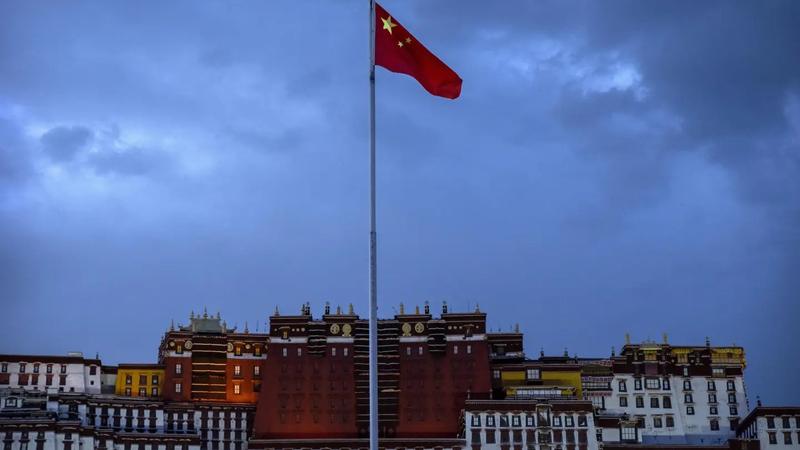Published 18:38 IST, May 29th 2024
During Sacred Month, Beijing Cracks Down on Tibetan Buddhists
Beijing's policies of suppression and Sinicization of Tibetan Buddhism aim to bring the religion under control of the party.

Chinese authorities have issued directives to Tibetan students, government workers, and retirees, instructing them to abstain from participating in religious activities in Lhasa during the Buddhist holy month of Saga Dawa. This information is based on 4 sources who spoke to Radio Free Asia.
Saga Dawa, a significant festival in Tibetan Buddhism, takes place during the fourth month of the Tibetan lunar calendar. This year, it spans from May 9 to June 6. The festival commemorates the birth, enlightenment, and parinirvana of Buddha.
Here is what you need to know
During this sacred period, thousands of Tibetan Buddhists undertake pilgrimages to Lhasa's temples and walk the revered kora routes around Lingkhor and Barkhor streets, encircling the Jokhang Temple. The ritual of kora, which involves making a circumambulation around sacred sites or objects, is considered highly virtuous. Tibetan Buddhists believe that the merits of such deeds are amplified during Saga Dawa based on their location.
However, since the beginning of Saga Dawa, Chinese police have ramped up security around major religious sites, including Potala Palace, Jokhang Temple, and the Barkhor area.
These heightened security measures are indicative of the worsening religious freedom situation in Tibet. The Chinese government’s policies of suppression and Sinicization of Tibetan Buddhism aim to bring the religion under the control of the Chinese Communist Party.
A deeper look
The Chinese Communist Party (CCP) has engaged in a sustained campaign to suppress Tibetan Buddhism in Tibet since the People's Liberation Army entered the region in 1950.
When the CCP took control of Tibet in 1950, it initially adopted a relatively conciliatory approach, recognizing the Dalai Lama as the political leader of Tibet. However, this changed dramatically following the 1959 Tibetan Uprising. The revolt, which was brutally suppressed, led to the flight of the Dalai Lama and thousands of Tibetans to India.
During the Cultural Revolution, the Red Guards destroyed thousands of monasteries, temples, and religious artefacts. By the end of this period, only a handful of monasteries remained intact out of the thousands that existed before 1959. Monks and nuns were forcibly secularized, subjected to public humiliation, and often sent to labor camps.
Beijing's control over religious leadership
The CCP insists on approving the selection of reincarnated lamas (tulkus), including the Panchen Lama. The most notable case is the disappearance of the 11th Panchen Lama, Gedhun Choekyi Nyima, who was detained by Chinese authorities and replaced by a state-appointed Panchen Lama.
Monasteries are required to incorporate "patriotic education" programs, which include the study of CCP ideology and Chinese laws. Monks and nuns must pledge loyalty to the state over their religious commitments. The CCP imposes quotas on the number of monks and nuns allowed in each monastery, limiting religious vocations. Monasteries are closely monitored by the state, with surveillance cameras and informants to ensure compliance with state regulations.
Restrictions on festivals and pilgrimages
Religious festivals are either restricted or entirely banned. For instance, major religious gatherings such as the Kalachakra initiation are often forbidden or tightly controlled. Travel to sacred sites both within Tibet and abroad is heavily restricted. Those caught participating in unauthorized pilgrimages face harsh penalties.
Cultural and Linguistic Assimilation
The CCP promotes Mandarin over Tibetan, especially in education and official settings. This undermines Tibetan as a medium of religious instruction and daily life. Traditional Tibetan customs and rituals are discouraged, and Han Chinese migration into Tibet is encouraged to dilute Tibetan cultural identity.
Crackdown on Religious Expression and Dissent
The extensive surveillance network extends beyond monasteries to the general populace, monitoring religious activities and expressions of dissent. Monks, nuns, and laypersons who resist CCP policies or engage in unauthorized religious practices are often arrested, imprisoned, and subjected to torture. High-profile cases include the imprisonment of figures like the abbot of Tashilhunpo Monastery.
Ideological Indoctrination
Schools and monasteries are required to teach CCP ideology, with a focus on portraying the Party as the liberator of Tibet from feudalism and superstition. State-controlled media disseminate propaganda that portrays Tibetan Buddhism in a negative light while glorifying CCP achievements in the region.
The suppression has led to a significant erosion of Tibetan cultural and religious identity. Continuous repression has caused widespread psychological trauma among Tibetans, contributing to acts of self-immolation in protest.
Despite the extensive suppression, Tibetan Buddhism remains resilient. The Tibetan diaspora, especially in India, continues to preserve and promote Tibetan culture and religion. The Dalai Lama and other Tibetan leaders in exile have worked tirelessly to bring international attention to the plight of Tibet.
Updated 18:38 IST, May 29th 2024




